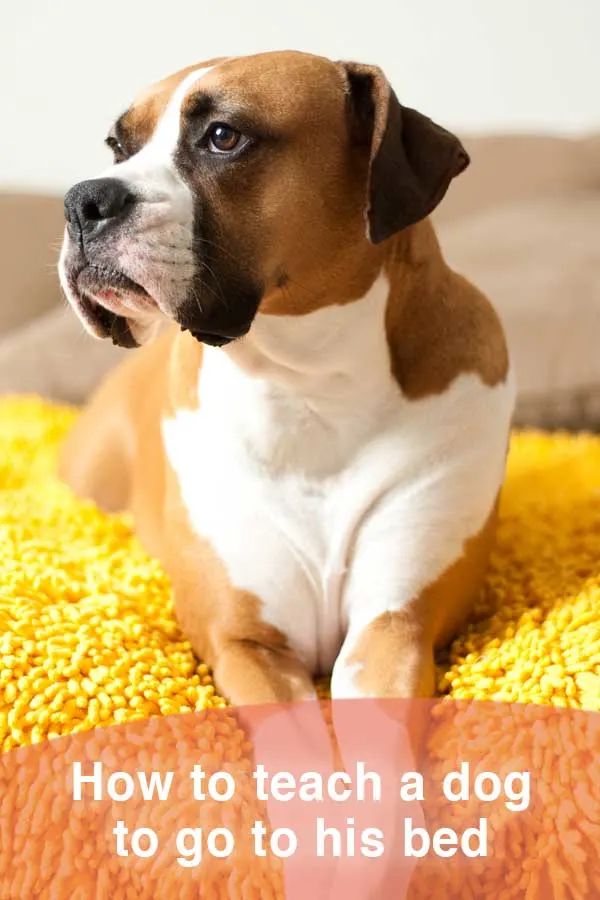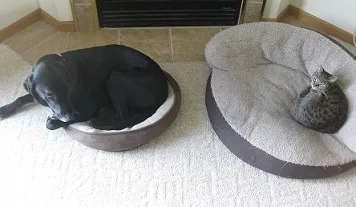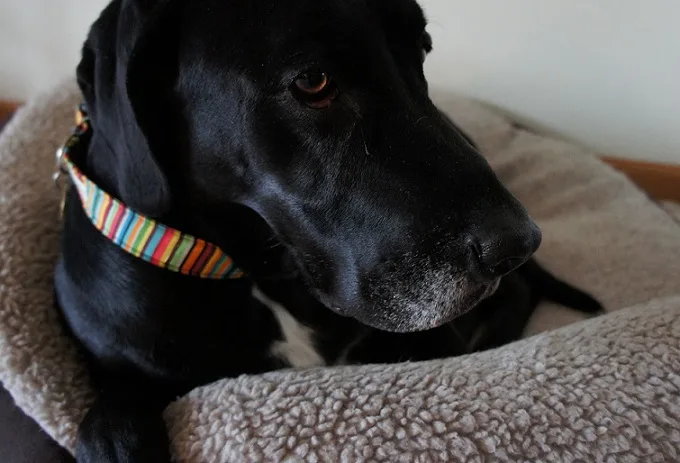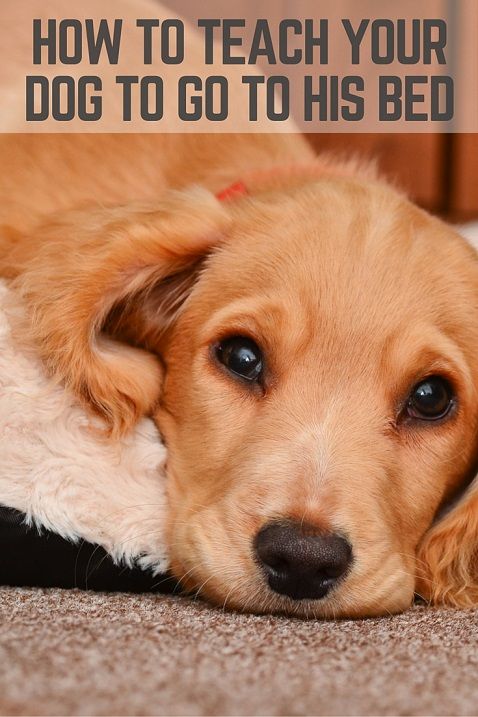There are multiple ways to teach a dog to go to her bed. The following are my own ideas. Please share your own tips in the comments.
Teaching a dog to go to her bed (or to her mat or to her kennel) is a very useful command because there are times when we don’t want our dogs invading our personal bubbles!
When to use “go to your bed command”
The “go to your bed” command comes in handy in many situations such as:
- When you have visitors over
- When you’re eating dinner
- When you’re busy and don’t want to be pestered
- When you have multiple dogs and need them to “chill out”
- When you’re working on a project and need your dog out of the way
- To get your active dog to calm down
I chose to use the phrase “go to your bed” as a command that means “go to your bed and stay there until I release you.”

Another option is just encourage your dog to lie on her bed and then give the command “stay.” I just like to be able to send my dog to his bed so he will go there on his own and stay there.
How to teach a dog to go to her bed
This is a very easy concept to teach a dog. It’s just a matter of consistency on your part.
Step #1: Lure your dog to her bed with treats
Toss treats on your dog’s bed or lure her there with a treat.
If she puts one paw on the bed, say “good” or “yes” or click your clicker and give a treat.
You can give a few more treats as long as she has at least one paw on the bed. Give more treats and praise if she moves two paws or all four paws on the bed.
Don’t worry about having her in a sitting or down position for now.
Pause a moment, toss a treat away from the bed and say “ok” or “off” or whatever word you use to release your dog.
I use “off” for when I want my dogs to step off of something.
Repeat this a few times for just a few minutes and then quit. You don’t want to train for too long or your dog might get bored.
So at this point your dog is only going to the bed for a few seconds and you’re not even using a command/cue yet.
Step #2: Start using a cue like “place” or “go to your bed”
Do the same as above, but begin saying a cue like “place” or “go to your bed.”
You can still lure your dog for a couple of training sessions, as needed.
Eventually, begin using your cue. Pause and wait for your dog to go to her bed. Then reward.
Step #3: Begin increasing the distance
You probably won’t want to start increasing the distance until after several training sessions.
Once your dog is happily making a dash for her bed when you use your cue, you can start standing further away from the bed when you give your cue.
Up until this point, you’ve probably been standing right next to your dog’s bed and looking at it or pointing at it. So, try to move a step or two away from it and gradually stop pointing to it (although you can continue pointing, if you don’t mind doing so).

Increase the difficulty very gradually so the dog is successful. If your dog struggles, always go back to an easier step for a few training sessions.
Remember to keep training sessions short and fun, only a few minutes.
Step #4: Increase the time your dog is required to stay
You want to keep using your release cue such as “Ok” or “off” to let your dog know she can step off her bed.
Up until now, you’ve probably only been having her stay on her bed for a few seconds.
Now is the time to slowly start increasing that time to 10 seconds, 20 seconds, 30 seconds, and so on. Use your release word and praise her for success. Always take a step back if she is failing.
Ideally your dog would then stay on her bed for up to 10 minutes or more while you’re doing something else but you need to very gradually work up to that point. And don’t put high expectations on a puppy.
If your dog knows the command “stay” then it’s OK to use that to encourage your dog to stay. Personally, I don’t like to use “go to your bed” and “stay” because “go to your bed” implies the dog should stay. But it’s up to you.
At first, you’ll only expect your dog to remain on her bed for five seconds while you’re sitting right next to her. Give her treats and praise. Then release her with “free!”
If your dog doesn’t listen and leaves her bed before you release her, just calmly say “no” and put her back on her bed. Wait a second or two, then release her.
If she’s getting up, then you know you’re challenging her too much or maybe it’s time to take a break from training. Also watch for signs of stress such as scratching around her collar.
Of course, it helps to have a comfy bed your dog loves to spend time on. I recommend the PupRug beds from Paw.com.
Step #5: Practice distractions
Now you can begin to walk away from the bed. At first, you might take a single step back. Then return to your dog and release her.
Next, you would take two or three steps. Then four. Then maybe you can sit on the couch for 30 seconds. Then a minute. Every dog will be different.
Puppies will obviously have a harder time sitting still. Dogs that don’t have strong obedience skills will also struggle. Dogs that have a rock-solid down/stay command mastered will have less trouble with this.
Other distractions you can begin introducing to your dog while she’s staying on her bed:
- Run in circles
- Toss a toy
- Make a knocking sound on the wall
- Say “who’s here?”
- Prepare a snack for yourself
Obviously, you need to go at your dog’s pace.
Be positive. Use lots of praise and treats. Make sure your dog views her bed as a fun place to hang out.
More tips for teaching your dog to go to her bed
- Give your dog a special treat when she’s lying on her bed such as a bone or a puzzle toy
- Give your dog the “go to your bed” command before you feed her
- Give the “go to your bed” command before heading out for a walk
- Keep your dog on a leash during training if it helps
How about you? Do you use the “go to your bed” command? How did you teach it?
*Enjoying this article? Get realistic dog training tips emailed once a week. Click Here
Related posts: How to teach your dog the place command
Lindsay Stordahl is the founder of That Mutt. She writes about dog training, dog exercise and feeding a healthy raw diet.




Jen
Monday 22nd of January 2018
We took our rescued American Bully to the vet, who told us that her hind legs had been broken and improperly set, and surgery will help, but she'll always have joint issues. So I went out and bought her a $160 orthopedic pet bed.
Which she was utterly petrified of.
We have no idea why, something about it just terrified the hell out of her. But she was also completely phobic of the vet (or anyone in a white coat), and she seems to flinch around dark-haired men who are less than 6 feet tall. One of our friends in particular, she gets so panicked, she will literally run people over in her attempt to get away from him. So we figure it's just something from her past, and we need to get her over it.
Only the most high-value treats and me in a super patient and gentle mood were enough to coax her to put just one paw on the bed. It took weeks of working almost every day, but it was worth it when I watched her walk up and curl up in the bed on her own.
Big, 70 pound pit bull, terrified of a bed. She'll actually sleep there now, but me telling her to go to her bed still makes her nervous. I have to be super careful of my tone or she'll think she's in trouble and being sent to the bed as a punishment.
Half an hour seems like a lofty goal right now. We're still only at about 5 minutes before she starts getting anxious, but that's a lot better than the 30 seconds it was a month ago. And I know that with patience and persistence, she'll get up to half an hour. It's always reassuring to know that other people are having the same struggle.
Donna
Tuesday 11th of July 2017
Nice tips
EmilyF
Thursday 2nd of February 2017
Somehow, I inadvertently taught my rescued German Shepherd Baron to stay out of the kitchen when we sit down to eat. My bf had tendency to allow Baron to beg at his side while he ate, and usually gave him scraps from the table, even if I told him not to. Well Baron's begging just got to be too much. So I started telling him to "back up" and "out" once we sat down at the table. He backs up his little wiggle-butt until all 4 feet are off the kitchen tile and on the living room carpet. He'll lay there and stare at us while we eat, but its so much more peaceful than being begged at! (Also slowly training my bf that Baron can have certain dinner scraps if its presented to him in his food bowl and he has to sit, shake, do something to earn the treat!) They're both learning nicely :)
Lindsay Stordahl
Friday 3rd of February 2017
Haha! That is great!
Nancy's Point
Sunday 5th of January 2014
This is one of the easiest commands to teach because most dogs actually like their beds, so going to their beds isn't asking them to do something they don't like. At least this is the case with my dogs. And if they still get to be in the same room with you, all the better! I do have to use the stay command as well for one of my dogs. But that's okay. Great tips!
Kimberly Gauthier
Tuesday 17th of December 2013
I clicked over, while patting myself on the back (yep, I'm talented), because I've taught our dogs to go to their bed (and their condo, and their blanket). But as I was reading, our dogs will not do any of these things if someone comes to the door.
Thanks for giving us something to work on, because this would be handy.